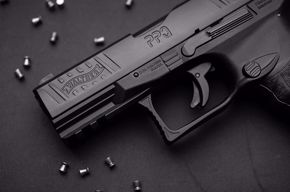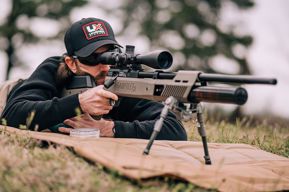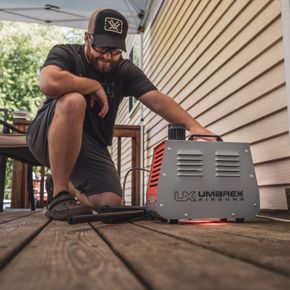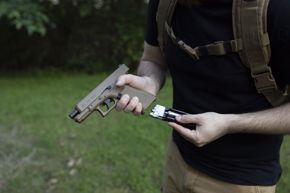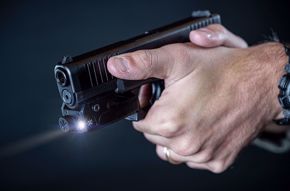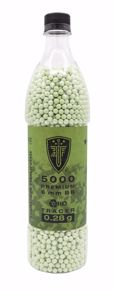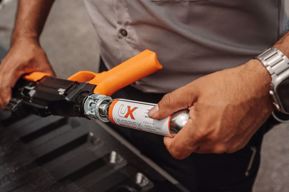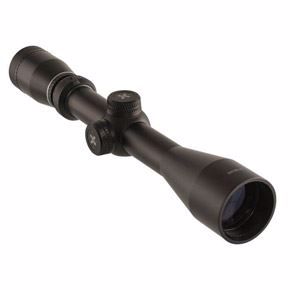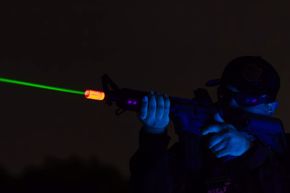I am a child of the 1970s. And it is a miracle that I survived the 1980s. When I was in middle school, all of my friends had pump action BB guns. I did not. My parents knew better than to trust me with one. That didn’t keep me from wanting one.
The new Strike Point is both entirely new and yet oddly nostalgic for me. It is a pistol, yet it has that same clack-clack-clack sound that meant I was having fun (and likely up to some mischief) as a kid. And I had a hell of a good time with it on the range.
Let’s start with the outward design. The Strike Point is long, 14 inches overall. It has to be a bit stretched out to incorporate the pump action. That extra length, though, provides you with a longer sight radius and a longer barrel, both of which aid in accuracy.
The Strike Point is wrapped almost entirely in polymer. This reliance on plastics prevents the Strike Point from being too barrel heavy. You can easily balance this gun in a two-handed grip like you would any centerfire pistol.
The long sight radius is complemented by an adjustable rear sight. In the front, a fiber-optic post is shrouded completely. The rugged design is useful as this is a gun that you’re going to want to take with you in your backpack.
The pump arm moves easily. You can fire a pellet with as few as three pumps or pump it up to 10. This variation greatly affects the speed of the pellet. When pumped all the way to 10, the Strike Point is kicking out .177 pellets at 630 FPS. The one I reviewed is a .22, and I was getting speeds that averaged 515 FPS with 10 pumps.
Most of the shooting I did with the Strike Point was at modest ranges between 10 and 30 yards. I did shoot some targets as far away as 50 yards. At that distance I had to arc pellets in, but I was still making solid hits.
In order to get the pump to charge the gun, you have to pull back the bolt. If you do not and you actuate the pump arm you will feel no pressure buildup. Once the bolt is the entire way back, pump it is many times as you would like. When you’re finished insert a pellet and slide the bolt home.
You can load the pellet before you pump. At first I saw this as a safety issue. When pumping a pistol, I find my hands hovering around the trigger guard in a way that made me feel slightly unsafe. When I actually took the Strike Point out into the field and put it into practice, I realized there was no need for concern. The safety is a cross bolt design that is easy to actuate. The fact that you can pump the Strike Point by sliding the bolt back when it is unloaded means there is no safety concern whatsoever. Even if you had the safety off and accidentally brushed the trigger, it wouldn’t pose any risk.
It is precisely this safety feature that I think makes the Strike Point such a good teaching tool. If you have someone who is new to shooting and you want to instill some good habits, this is the way to go. You can very easily control all of the variables from the speed of the shot to the point in the process when the pellet is actually loaded.
One of the most important aspects of teaching is the reward of well-executed skills. Even on three pumps the Strike Point maintains accuracy. At 10 pumps that accuracy could be lethal for small pests, especially in .22 caliber.
And this is the first multi-pump pistol with the SilenceAir technology built in, so it isn’t that loud. The clack of the pump is louder than the shot itself.
One thing I would recommend about the use of the Strike Point is that you keep your fingers clear of the pump as it closes. The pump’s handle has a plastic grip that feels very similar to a small forend. In the last second before it closes, it snaps shut. If you get a little bit of skin caught between the frame and the pump, it will clap shut on that skin. It hurts. Don’t ask me how I know this. All I will say is that this is a mistake you aren’t likely to make twice.
The Strike Point is the type of air gun you’ll want to shoot with friends. The reason why I say that is that you’re going to need a break after a good shot string. If you were pumping 10 times between each shot, the motion can feel repetitive. It isn’t that it requires as much strength as a break action, but by pumping over and over and over again as I did on the range begins to wear down one arm.
This is my favorite safety design for a handgun. As you bring your finger to the trigger guard, if you are right-handed, your finger will hit the safety and you can depress the safety while moving to the trigger. It is very efficient.
David Higginbotham is a writer and educator who lives in Arkansas. After years of writing and consulting in the firearms industry, he's coming back to his roots with air guns.

